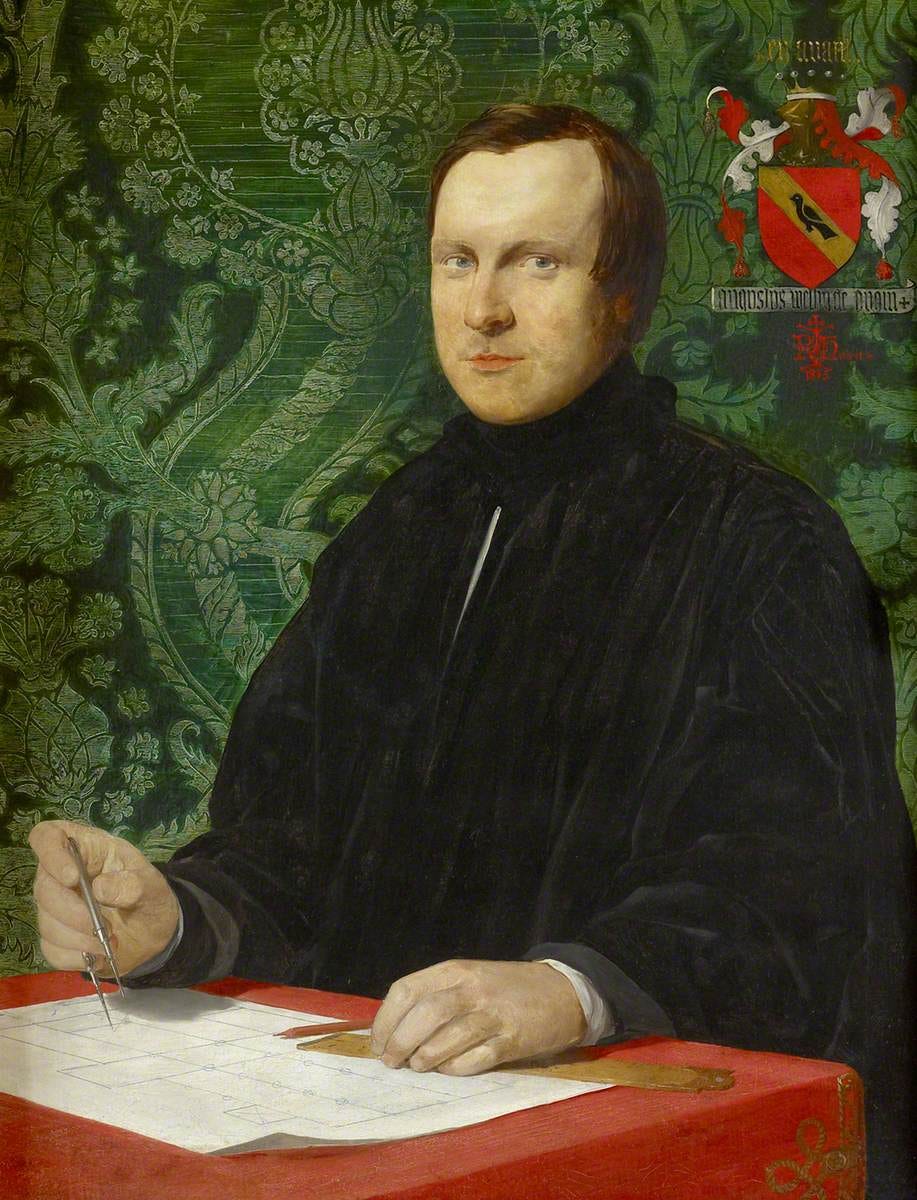Colin Nagy | March 14, 2024
The A.W.N Pugin Edition
On architecture, Gothic Revival, and ornamentation
Recommended Products

In 1835, Pugin significantly raised his profile with the book 'Contrasts: Or, A Parallel between the Noble Edifices of the Middle Ages and Corresponding Buildings of the Present Day', which compared the virtues of medieval society to the vices of modern society.
Mark Mulhern lives in New York. He started his career in advertising but is now the CMO of Consello, an advisory and investment platform. He has bought a pencil for every iPad he has owned but remains frustratingly incapable of drawing. He does, however, appreciate the great artistic works of others- especially architects. -Colin (CJN)
Mark here. Augustus Welby Northmore Pugin (1812-1852) was a British architect, decorative artist, and writer. He was a leading figure of the Gothic Revival movement, and a prolific designer of everything from churches and houses to furniture, textiles, ornamentation, and objects.
Pugin’s work was a major influence on the appearance of Victorian-era Britain, and his polymathic genius is best embodied in his most famous work: London’s Houses of Parliament. Victorian Britain was a period of extraordinary industrial and societal change, marked by rapid technological innovation (Steel! Steam engines! Railways! Photography! Sewing machines!), intellectual progress (Darwin! Dickens! Eliot!), urbanization, and social upheaval.
Why is this Interesting?
Or, put another way, in an era synonymous with rapid progress, how did a medieval Christian design ethos become the leading architectural and design style of the day?
The answer is largely down to the frenetic, brilliant, but ultimately short-lived genius of Augustus Welby Northmore Pugin, the father of the Gothic Revival.
From an early age, it was clear Augustus had prolific talent. By 15, he was designing furniture for Windsor Castle. By 17 he had his own architecture and design practice. And by 18 he was designing stages for the Covent Garden ballet.
He was also a staunch critic of the industrial and societal progress of the Victorian era, which he believed represented a decaying society and, perhaps worse than that, a decline in the quality of architecture and design.
This all drove Pugin to convert to Catholicism, which he believed acted as a bulwark against societal (and architectural) deterioration. And with his fervent belief in Catholicism as the only true Christian religion came a belief in the Gothic style as the only true architecture.
With its verticality (Church spires, for example), pointed arches, and intricate ornamentation, Pugin argued that Gothic design was a spiritual style that could express the beauty and mystery of God and thereby restore order and morality to society. He committed his life to promoting two causes: the Gothic style and the Catholic faith.
In 1835, he significantly raised his profile (and became even less popular) with the book Contrasts: Or, A Parallel between the Noble Edifices of the Middle Ages and Corresponding Buildings of the Present Day, which compared the virtues of medieval society to the vices of modern society. His growing notoriety brought numerous commissions, especially from Catholic parishes and aristocratic families. (Ultimately, Pugin would design over 117 churches, civic buildings, and great homes across Britain and Ireland.)
In the very same year, a competition was announced to pick the architect for a new Houses of Parliament after the previous building had burned down the year before. Leading architect Charles Barry engaged 23-year-old Pugin as a draftsman, and together, they prepared the winning entry.
Immediately, Barry invited his young aide to collaborate with him on the interior decoration of this massive project. Pugin was to be responsible for the stained-glass windows, intricate wood carvings, flooring, metalwork, textiles, furniture, and other decorative elements. In terms of scale and prominence, there could be no better canvas on which to express the potential of Gothic design to inspire and uplift a society.
Barry and Pugin often clashed over the details of the design, but over the 16 years it took them to finish the build, the two formed a profoundly effective partnership. Pugin ultimately also contributed to the external architecture when he designed the iconic clock tower that still contains a massive bell named Big Ben.
The Houses of Parliament live on as both a masterpiece of the Gothic Revival style,
and their completion in 1852 added momentum to the Gothic movement, with the style continuing to influence London’s buildings for another two decades.
Sadly, that revival continued without its key instigator. Pugin suffered both mental and physical breakdowns due to a life of frenetic work, sickness and personal challenges, and died in September 1852.
Thanks for reading,
Noah (NRB) & Colin (CJN)
Why is this interesting? is a daily email from Noah Brier & Colin Nagy (and friends!) about interesting things. If you’ve enjoyed this edition, please consider forwarding it to a friend. If you’re reading it for the first time, consider subscribing (it’s free!).

